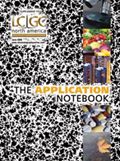From the Publisher: Offering Solutions to Today's Problems
The Application Notebook
It is no secret that these are tumultuous times we live in. With the economic slowdown, increased dangers abroad, and the recent string of scares involving toxins in everyday foods, there is no shortage of things to worry about in today's world. At LCGC, we've always felt that our Application Notebook is a reflection of not just the recent developments in chromatography and the field of separation science in general, but the world as a whole.
It is no secret that these are tumultuous times we live in. With the economic slowdown, increased dangers abroad, and the recent string of scares involving toxins in everyday foods, there is no shortage of things to worry about in today's world. At LCGC, we've always felt that our Application Notebook is a reflection of not just the recent developments in chromatography and the field of separation science in general, but the world as a whole.

Michael J. Tessalone
In these pages, you'll find application notes on the detection of chemical warfare agents, the analysis of melamine in milk supplies, reducing solvent usage for savings in the lab, and more, all reflecting issues and crises that have come to the forefront in our society as a whole. It has often been said that there is no point in identifying a problem without offering a constructive solution as well, and in The Application Notebook, you will find an entire issue dedicated to solving problems, as we follow LCGC's motto of offering "Solutions for separation scientists."
As usual, myself and our staff will be out in the marketplace as much as possible in the coming months, as the summer and fall have a busy schedule of conferences and symposia slated, so please feel free to give us your feedback on this or any of our other issues either in person or via the contact information on the masthead. This summer in particular will give readers and advertisers the chance to find all of LCGC's staff in one place at our second annual PharmSep Symposium, to be held in Philadelphia, Pennsylvania, September 21–22, so we hope you will attend. For more information on this event, just visit: www.lcgcevent.com.
In the meantime, we hope you enjoy this issue and the market barometer it provides, and we look forward to seeing as many of our readers and advertisers as possible over the coming months.

Michael J. Tessalone
Science Group Publisher

A Matrix-Matched Semiquantification Method for PFAS in AFFF-Contaminated Soil
Published: April 14th 2025 | Updated: April 14th 2025Catharina Capitain and Melanie Schüßler from the Faculty of Geosciences at the University of Tübingen, Tübingen, Germany describe a novel approach using matrix-matched semiquantification to investigate per- and polyfluoroalkyl substances (PFAS) in contaminated soil.
Silvia Radenkovic on Building Connections in the Scientific Community
April 11th 2025In the second part of our conversation with Silvia Radenkovic, she shares insights into her involvement in scientific organizations and offers advice for young scientists looking to engage more in scientific organizations.




















